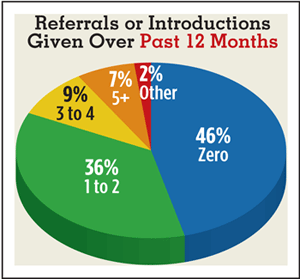Atlanta: “I need more leads,” stated Taylor as we ended the webinar. A pause ensued and he continued, “That’s really my biggest issue. I need to figure out how I can get in front of more affluent prospects. My network is growing and I’ve received a few referrals, but my luck is running out and I have hurdles to meet.”
Luck? We couldn’t help but cringe. Any plan based on luck isn’t much of a plan. What Taylor needed was a proven way to get face-to-face with the affluent. We decided to take Taylor through our latest research and show him how to practically apply it to his budding business.
Our 2012 Affluent Investor Study (Investors with $500K or more in investable assets) states that if you maintain a business and social relationship with your client, there is an 86.3% chance they’ll introduce you into their spheres of influence. Naturally, like most new advisors, Taylor didn’t have many affluent clients. This means he’ll need to need to work the introduction process on non-clients as well. This includes clients, COIs friends and anyone else that can connect him with the right people.
This doesn’t mean that everyone you know will be a great source of introductions. Applying the ever-powerful 80/20 rule to introductions and referrals, we know that a handful of Taylor’s connections will be responsible for the majority of his new business opportunities.
Our 2012 Affluent Research confirms that only 16% of affluent clients gave 3 or more referrals or introductions over the past 12 months. In our coaching process, we call these clients “Connectors” and they drive the majority of new business opportunities to advisors. The secret is identifying the Connectors in your book (and life) and helping them help you. For instance, Taylor’s Uncle Fred is a New York attorney as is his Uncle Bob and three older cousins. When we asked Taylor if they we’re internal advocates and wanted to help him succeed, he stated “I would be shocked if they didn’t.” We then asked Taylor, “Are you leveraging your Connectors enough?” His silence provided us with the answer.
Finding Your Connectors
In his book, The Tipping Point, Malcolm Gladwell identifies Connectors as people who naturally speak out and tell others about your services. These people readily spread word-of-mouth influence. Your objective is to find the Connectors within your book or spheres of influence.
If you have a client-base, start by making a list of your top 25 clients. If you are like Taylor and don’t have much of a client base, make a list of any COIs, friends, family, former colleagues, etc. who can put you in front of people of wealth. This might be Uncle Bob, an old sorority sister, a friend at law firm, etc. This is anyone who openly speaks about your services and wants you to succeed. Your Connectors can be recognized by looking for the following traits.
• Readily brings you into their spheres of influence
• Easily speaks out about your services
• Provides you with frequent introductions and referrals
• Interacts with ideal potential prospects
• Frequently provides unsolicited positive word-of-mouth
• Opinions are respected within their spheres of influence
• Openly wants you to be successful in your new career
If they meet at least three of the above criteria, you can consider them a Connector.
Leverage Your Connectors
With your Connectors now identified, create a strategy to fully leverage their clout (social influence). Connectors need to know how to spread your message and what clients you are looking for. Leverage your Connectors by doing the following:
1. Get face to face. Managing relationships requires a personal touch. Getting face-to-face with your connectors on a regular basis (once a month at least), keeps them current on your situation, and allows you to find ways they can help you.
2. Let your value proposition become theirs. Do your connectors know how to explain what you do for potential prospects? Don’t be afraid to script them on the subject. Ultimately, you want your Connectors to be able to articulate your value without pigeon holing you as a “broker.” This happens through spaced repetition. During each review, each social interaction, each referral and introduction, every chance you get, you reinforce what you actually do.
3. Your connectors should also know when to speak of you in a business context. Your objective is to take their advocacy beyond simply referring you if specifically asked for a recommendation for an advisor. Ideally, if they have a friend who is venting about the economy, the markets, a pending divorce, etc. you want them to think of you. You want to have a conversation with your Connectors around when it is appropriate to bring you into a conversation.
4. Train them on the art of introductions. As more and more prospects are referred your way, let your Connector know that you would prefer a personal introduction to that person. Over time, your Connectors will skip the referral step and start scheduling personal introductions. This can happen over a simple lunch or at a baseball game; it’s sure to increase your close ratio.
Taylor was probably a little overwhelmed and excited at the same time. We just gave him a path to run on but it was up to him to make it happen. As a new advisor, there is no shortage of ideas to bring in business. However, with a little guidance, your Connectors are a potential goldmine. In a world abundant with skeptics and cynics, word-of-mouth influence reigns.



